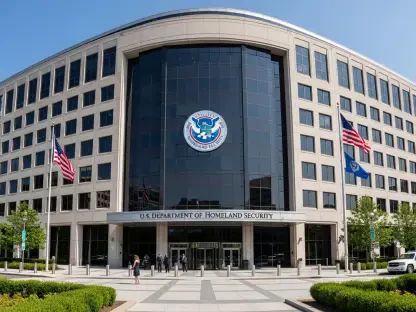What happens when the protectors of a nation’s digital frontiers are redeployed to guard physical borders instead, leaving critical systems vulnerable? In a startling development, experts from the Cybersecurity and Infrastructure Security Agency (CISA) have been shifted to roles in immigration and border security under the Department of Homeland Security (DHS), raising serious concerns. This move comes at a time when cyberattacks are surging, targeting everything from power grids to hospital systems. With critical infrastructure hanging in the balance, this reassignment sparks an urgent debate about whether political priorities are compromising the safety of essential digital networks.
The significance of this issue cannot be overstated. CISA serves as the backbone of U.S. cybersecurity, defending against threats that could disrupt daily life for millions. As foreign adversaries and criminal hackers grow bolder, the agency’s expertise is indispensable. Yet, the decision to divert personnel to support immigration enforcement raises alarms about whether the nation is prepared for the next major cyber incident. This story delves into the controversy, exploring the risks, the voices on both sides, and what it means for every American relying on secure systems.
A Looming Cybersecurity Crisis?
The digital landscape is under constant siege, with recent breaches exposing vulnerabilities in systems that underpin modern society. Just consider the penetration of F5 systems by Chinese state-aligned hackers—a breach so severe that CISA had to step in with emergency measures. Such incidents highlight the agency’s critical role in safeguarding national security. However, the reassignment of key staff to unrelated duties has ignited fears that defenses are being stretched dangerously thin.
This shift isn’t happening in a vacuum. Amid a federal funding lapse, the timing of these reassignments amplifies concerns about readiness. Critical divisions within CISA, responsible for coordinating with private companies and local governments, are losing manpower to immigration tasks. The question looms large: if a major cyberattack strikes now, will there be enough expertise on hand to respond effectively?
CISA’s Indispensable Role in National Security
CISA stands as the first line of defense against a spectrum of cyber threats targeting vital infrastructure. From ensuring the integrity of election systems to protecting water treatment facilities, the agency’s mission touches every corner of American life. Reports indicate that cyberattacks on critical sectors have increased by over 30% in the last two years alone, underscoring the growing need for robust protection.
Beyond raw numbers, the stakes are deeply personal. A single breach in a hospital network could delay life-saving treatments, while a compromised power grid might plunge entire cities into darkness. With adversaries like nation-state hackers employing increasingly sophisticated tactics, CISA’s specialized skills are not just valuable—they are irreplaceable. Diverting these resources to other priorities risks creating gaps that enemies are eager to exploit.
Despite this, the pressure to reallocate personnel persists. The tension between maintaining cyber defenses and addressing other national demands reveals a troubling dilemma. How can a balance be struck when the consequences of failure in either domain are so catastrophic? This challenge lies at the heart of the current controversy.
Dissecting the Reassignment Debate
At the core of this issue is a complex web of legal and ethical questions. House Democrats have raised serious objections, claiming that DHS’s actions may violate the Antideficiency Act by spending unappropriated funds during a government shutdown. Such a breach, if proven, could set a dangerous precedent for how federal resources are managed in times of crisis.
Beyond legality, the operational impact is equally concerning. Key CISA divisions tasked with building partnerships across public and private sectors are seeing their teams diminished. These relationships are vital for sharing threat intelligence and coordinating rapid responses. When staff are pulled away to support immigration initiatives, like expanded detention efforts, the ripple effects could weaken the entire cybersecurity ecosystem.
Moreover, the scale of this redirection signals a prioritization of political objectives over foundational security needs. Critics argue that tens of billions of dollars funneled into border enforcement should not come at the expense of digital safety. The debate isn’t just about numbers—it’s about whether the nation’s values align with protecting its citizens from invisible but devastating threats.
Perspectives of Concern and Justification
Voices from Capitol Hill paint a stark picture of the risks involved. Rep. James Walkinshaw (D-Va.) has been vocal, warning that “diverting cybersecurity experts to serve a political agenda puts American lives at risk.” This sentiment, shared by several Democratic lawmakers in a formal letter to Homeland Security Secretary Kristi Noem, emphasizes the potential for catastrophic failures in infrastructure protection.
On the other side, DHS Assistant Secretary Tricia McLaughlin offers a contrasting view, defending the reassignments as a necessary adjustment to meet broader mission goals. Dismissing accusations of unpreparedness as “ludicrous,” the department asserts confidence in its ability to handle multiple challenges simultaneously. Yet, this reassurance does little to address specific worries about diminished capacity in the face of documented cyber incidents.
The clash of perspectives reveals a deeper divide over how national priorities should be ordered. While one side sees an existential threat in weakened cyber defenses, the other frames the issue as a manageable reshuffling. This disagreement underscores the urgency of finding clarity on how such decisions are made and justified to the public.
Striking a Balance Amid Competing Demands
Navigating this crisis demands a structured approach to ensure neither cybersecurity nor other national needs are neglected. A starting point could be conducting thorough impact assessments to gauge how reassignments affect CISA’s response capabilities. Without hard data, decisions risk being driven by politics rather than practicality, potentially leaving critical systems exposed.
Transparency also plays a crucial role. DHS must publicly outline its strategy for maintaining robust cyber defenses while managing these personnel shifts. Clear communication can help rebuild trust and demonstrate that contingency plans are in place. Additionally, stricter adherence to legal frameworks, such as the Antideficiency Act, is essential to prevent future missteps during funding lapses.
For the public, staying engaged is equally important. Advocating for bipartisan support of cybersecurity initiatives can pressure policymakers to prioritize digital safety alongside other concerns. As threats evolve, ensuring that agencies like CISA are adequately resourced becomes a shared responsibility, one that transcends partisan lines and focuses on the common good.
Reflecting on a Path Forward
Looking back, the reassignment of CISA personnel sparked a heated debate that exposed vulnerabilities in how national priorities are balanced. The warnings from lawmakers about weakened cyber defenses clashed with official assurances, leaving many to wonder if enough has been done to protect vital systems. Each side presented compelling arguments, yet the underlying risks remained a stark reminder of the stakes involved.
Moving ahead, actionable steps emerged as a necessity. Policymakers need to commit to regular evaluations of agency capacities, ensuring that no single mission undermines another. Establishing emergency protocols to prevent staffing shortages during crises became a priority. Moreover, fostering public dialogue about the importance of cybersecurity helps elevate its place in national discourse, urging leaders to act with foresight rather than reaction. These measures offer hope that past oversights will inform stronger, more resilient strategies for safeguarding the nation’s digital future.









